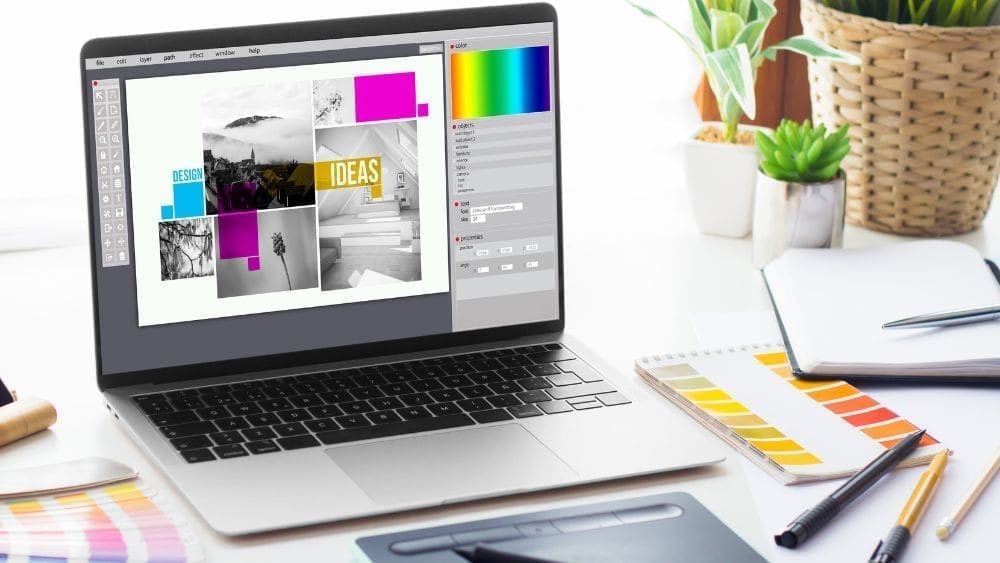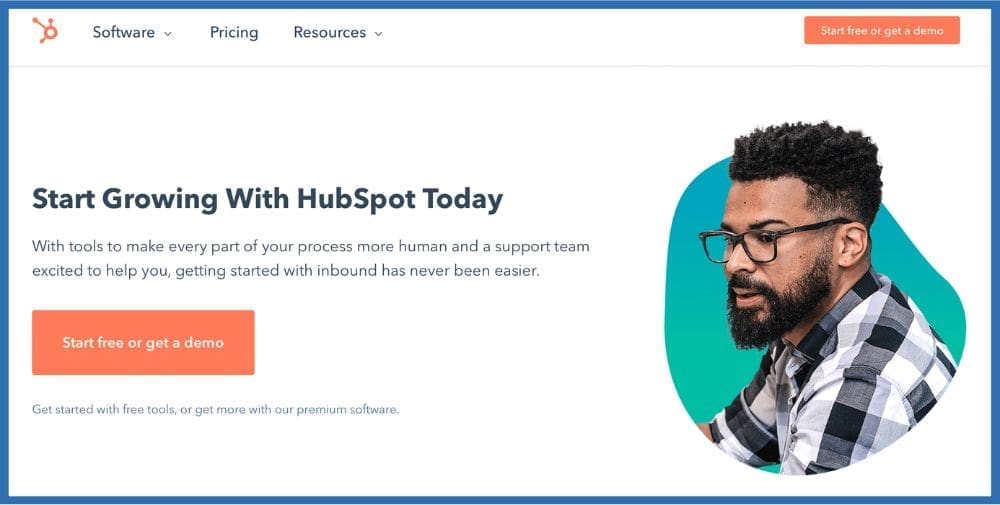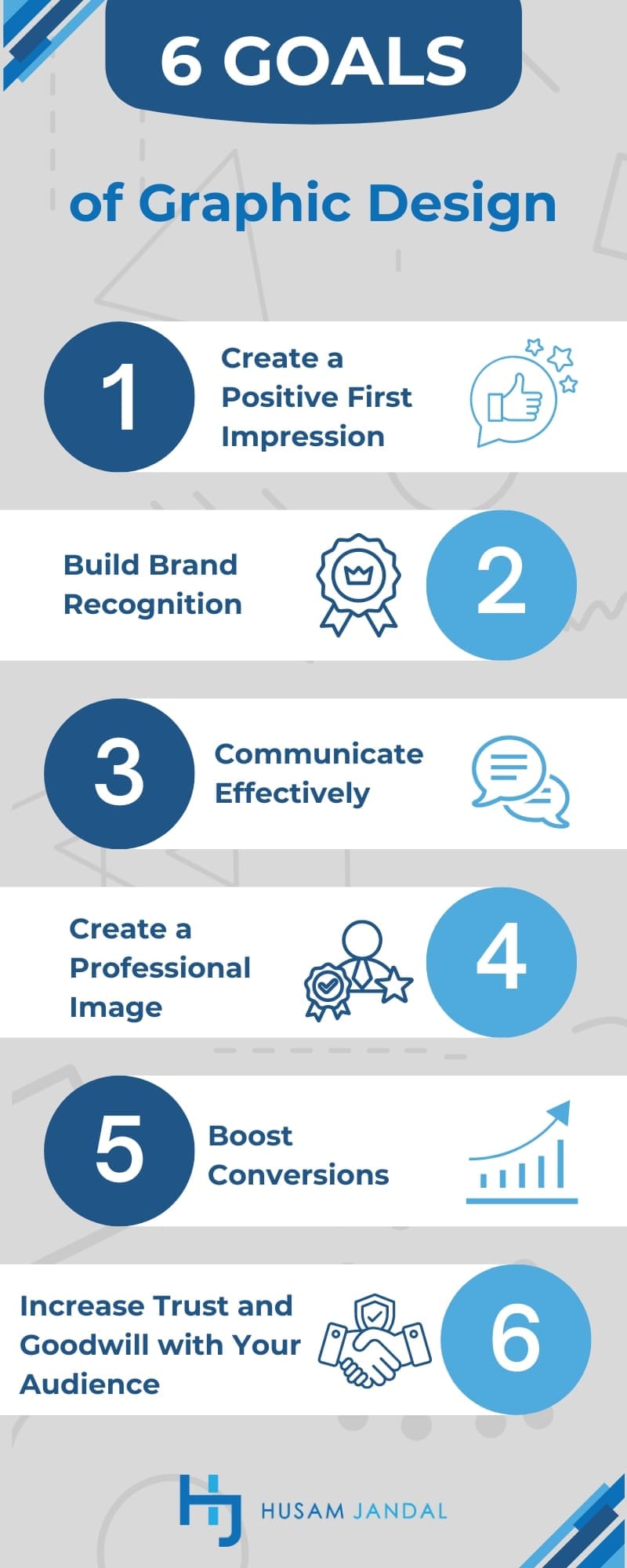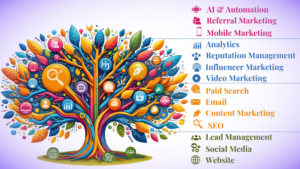
It’s often said that a picture is worth 1,000 words. This rings true today, especially if you’re using quality graphics in your digital marketing. But, which is best for your business: outsourcing graphic design and creative work or managing it in-house? And, if you do outsource, what’s the best way to get started?
These aren’t straightforward questions, despite what some might suggest. I’ll walk you through the details on this page so it’s easier to make the right choice for your company and select the best path forward.
Why Your Business Needs a Graphic Designer
Did you know that people focus their attention on images when they land on a page or open an email? Not only are graphics one of the first things people notice, but visitors spend more time looking at images than they do other elements on the page, as seen in eye-tracking studies shared by HubSpot.
Take this humble image below, for example.

Notice anything interesting about it? Chances are, you’re drawn to that big orange button, but do you know why?
A big part of it is the color scheme. Orange commands attention. The size of the button is another factor. You might also notice that the image, which has the company’s signature branded orange as a backdrop, showcases a man looking to the left. That’s not by chance! People naturally look where other people look, so you follow his gaze straight back to the button.
Goals of Graphic Design
The above examples highlight what a skilled designer can do for your digital marketing materials. Designers also deliver ROI by helping your business:

- Create a Positive First Impression
- Build Brand Recognition
- Communicate Effectively
- Create a Professional Image
- Boost Conversions
- Increase Trust and Goodwill with Your Audience
Job Responsibilities of a Graphic Designer
Graphic design school covers a lot of ground, from color theory through how to communicate via art and effective layout creation. A school’s goal is to help students find their way into one of seven graphic design specialties highlighted below, according to Rasmussen.
- Product Design: Examples include things like product packaging, marketing designs, and product illustrations.
- Branding Design: This includes logos, company letterhead, company brochures, and website branding fit within this bracket.
- Website and App Design: People often think of website development and website design as the same thing, but design is more about the user experience (UX) and whether the layout makes sense to a user and guides the person to the intended destination.
- Print Design: Brochures, flyers, branded merch (mugs, shirts, etc.).
- Publishing Design: eBook layouts, graphs, and book or magazine covers fall in this category.
- Environmental Design: Signage, store layouts, and museum exhibits fit into this design type.
- Animation Design: A few examples include animated social media graphics, animated explainers, and motion graphics for online videos. If you want your logo to appear animated, such as the way the original Disney logo would appear at the touch of Tinkerbell’s wand, this requires the help of an animation designer too.
Notice anything missing? There’s no singular niche dedicated to advertising and marketing. It’s an area creatives choose to pursue on their own. These professionals build up expertise in a variety of areas such as social media graphics, infographics, pay-per-click (PPC) banner images, whitepaper design, and PowerPoint presentations.
Is Creative Design and Graphic Design the Same?
When people talk about creative design and graphic design in digital marketing, they’re usually referencing the same thing. The terms are used interchangeably. However, some people split the two.
In these cases, graphic design usually represents the skill or activity. Creative design, then, relates more to problem-solving or choosing the best way to convey an idea. Ergo, a creative designer may sketch out a great idea but not be able to turn it into digital marketing collateral. Likewise, a graphic designer may be able to apply design principles and use the tools but not be great with ideas.
Sometimes people consider graphic designers as generalists, too, as evidenced by the long list of graphic design specialties above. In these cases, creative designers, then, are niche-specific and work exclusively in digital realms. Even by this definition, though, they’re generally more concerned with creating a cohesive voice across platforms versus designing individual assets.
Skills Required of a Graphic Designer
If you’re hiring someone for graphic design and creative work in the field of digital marketing, you’ll need to dig deep to find out if their skills are a match for your needs and examine their portfolio carefully. For example, even if someone makes gorgeous sharable social media graphics, they may not be the best choice if you require infographics or a whitepaper. With that in mind, there’s no definitive list of skills your creative should have, but the following serves as a baseline:
- Composition
- Branding
- Layout
- Storyboarding
- Typography
- Color Theory
- Coding (CSS, HTML, etc.)
- Time Management
- Communication
- Problem-solving
- Teamwork
- Analytical Mindset
- Willingness to Accept Constructive Feedback
Tools Required by a Graphic Designer
Tools will vary based on the project and task at hand as well. A few common tools designers use in digital marketing include:
- Photo Editing, Image Creation, and Graphic Design Software (Adobe Photoshop, Pixlr X, etc.)
- Vector Graphic Design Software (Adobe Illustrator, GIMP, etc.)
- Motion Graphics and Visual Effects Software (Adobe After Effects, Blender, Nuke, Fusion Studio, etc.)
- Vector Animation Tool (Adobe Animate, Toonz, Toon Boom, etc.)
- PDF Creation Tool (Adobe Acrobat, Nitro Pro, Fixit PhantomPDF, etc.)
- Slideshow Creation Software (PowerPoint, Google Slides, Prezi, Keynote, etc.)
- Proofing/ Project Management Tool (ProofHub, Wrike, Asana, etc.)
What Does Successful Graphic Design Look Like?
Whether you’re outsourcing graphic design and creative work or managing it in-house, being able to measure the success of the work is essential. While certain aspects, such as creativity, are intangible, you can measure design based on areas related to quality, impact, time, and money. Your graphic design KPIs will be unique to your situation and may vary depending on the project or campaign. A few examples are highlighted below.
Quality-Related KPIs of Graphic Design and Creative Work
- Brand Colors, Fonts, and Other Style Guide Requirements Met
- Graphics Delivered in Required Resolution and Format
- Files Use Standardized Naming Convention
- Graphics and Source Files Archived for Later Use
- Projects Delivered in Preferred Manner
- Number of Revisions
Impact-Related KPIs for Graphic Designers
- Conversion Rates/ Image Clicks
- Time on Page
- Social Media Engagement (Likes, Shares)
Time-Related KPIs for Graphic Designers
- Response Times
- Delivery Times
- Milestones Met on Time
- Hours Spent on Revisions
Money-Related KPIs for Graphic Designers
- Project Completed Within Budget
- ROI Requirements Met
Outsourcing Graphic Design vs. In-House Graphic Design
Now that we’ve covered what to expect from your digital creative and the work they create, the big question is whether you should be outsourcing graphic design or investing in an in-house graphic designer. Your answer will depend on how you answer the next four questions.
Skills: Does Someone on Your Team Have the Ability to Fulfill the Role?
It’s good to have a close relationship with your graphic designer. The longer someone works on your materials, the better they’ll understand your brand image and branding elements. They’ll work quickly, and your materials will also have a more consistent look.
However, professional graphic designers who focus on digital marketing are a small subset, and even if you have one on staff or can find one, they may not have all the skills you need. Because of this, most companies tend to outsource and develop long-term relationships with one or more designers.
Tools: Can You Provide All the Required Tools?
You may have noticed Adobe appeared on the list of tools repeatedly. That’s not a fluke. Most of the tools mentioned come bundled in the Adobe Creative Suite, which costs more than $7,500 annually for businesses. It’s by far the most widely-used solution, and professional designers gravitate to it. Your creative may need other tools beyond this, which will be your responsibility to supply if you opt for in-house talent. Outsourced graphic designers procure their own tools, which is another reason many companies choose to bring on external help.
Time: Does it Make Sense Timewise to Have a Dedicated Design Professional?
If your business is at the point where you’re considering bringing on a graphic designer, the person generally should be a specialist, not a Jack of all trades. This will ensure you get professional results. It also keeps time wasted to a minimum, as someone who works on graphic design projects all day is going to create pieces much quicker than someone who just does it a couple of times per week or month.
Equally, most businesses don’t need a full-time graphic designer. You might have a few hours per week to give someone, but not likely enough to amount to part-time hours, let alone a full-time position. For these reasons, outsourcing graphic design usually works best.
Cost Comparison: What Does Outsourcing Graphic Design Cost?
Outsourcing graphic design and creative work are usually less expensive than hiring in-house talent. You may gasp a bit when you see hourly rates, but because experienced designers work so diligently, you’ll usually save money. You’re also not covering benefits and other employee-related expenses when you outsource, which increases savings even more.
Final Decision: Is Graphic Design Outsourcing Better?
Generally speaking, it’s overkill for most companies, especially small businesses, to have an in-house graphic designer. Particularly if you can develop a long-term relationship with outsourced talent, and this person not only gets to know your brand well but also puts systems in place to ensure consistency as other designers are brought in to fill skills gaps and create other types of content. It’s the best of all worlds.
How to Outsource Graphic Design Jobs

Most people think there are only two ways to outsource graphic design: hire a freelancer or retain an agency. In reality, there are three.
Option 1: Hire a Freelance Designer
There are many sites dedicated to finding a freelancer. It’s as simple as looking for a profile you like and selecting someone or posting an ad explaining what you’re looking for and requesting applications.
Benefits of Hiring a Freelance Graphic Designer
- Fits into almost any budget
- You can view a portfolio of work before hiring to gauge skills
- You can hire by project or specialty
- Generally, the least expensive option
- Can work as an extension of your team if you find the right fit
Drawbacks of Hiring a Freelance Graphic Designer
- You don’t necessarily retain ownership of the work
- You can set time limits but can’t really control how time is spent
- It’s easy to go over budget with revisions
- You may need to train and coach quite a bit
- Work may be inconsistent or low-quality
- It’s time-consuming to hire good freelancers
- You need to be sure you’re treating the person as a contractor, not an employee, per local guidelines
Option 2: Retain a Design or Digital Marketing Agency
Hiring an agency is a little more challenging, but you can find some agencies on freelance sites or search for local companies to help.
Benefits of Hiring a Design Agency
- Usually, little-to-no learning curve
- Work is generally consistent
Drawbacks of Hiring a Design Agency
- Most are general marketing agencies that may or may not specialize in design
- Some even outsource their design to freelancers, adding an extra layer between you and the person doing your work
- It’s challenging to ensure your vision and branding are followed because your designer is removed from your company
- You may be tied into a long-term contract with no guarantee of results
- Vetting agencies and examining their work can be time-consuming, plus there’s no guarantee that the person who produces your creative work will be the one who crafted the samples you’re viewing or that you’ll get results
- Agencies typically want to follow their systems and may not meld into yours
Option 3: Work with a Consultant
The third option is to work with a digital marketing consultant. Someone who helps build your marketing dream team from the ground up and ensures all the elements for success are in place.
Benefits of Hiring a Digital Marketing Consultant
- You don’t need to worry about finding the best solution—an experienced consultant will evaluate your situation and choose the best method
- You won’t be drained or confused by the hiring process—a solid consultant will find the best candidate for your needs
- Your digital marketing team will be cohesive and function as one unit by design
- Your KPIs will be monitored, and the approach adjusted to improve ROI automatically
Drawbacks of Hiring a Digital Marketing Consultant
- It’s not a one-and-done deal—your consultant will want to help shore up all your marketing processes, which may not be ideal if your business isn’t ready to grow
- Although ROI increases to account for the additional expenses, you’ll have more upfront costs
Level Up Your Digital Marketing
As a digital marketing consultant with a background in business, I’ve helped multinational corporations and Fortune 100 companies level up. One area of special concern in every project is making sure the right talent is in place. Sometimes that means coaching an in-house creative and providing them with the resources they need to produce results. Other times, outsourcing graphic design is the best way to achieve the desired look and meet KPIs. If you’re not sure what the best path forward is, or you’re ready to scale in a big way, let’s have a conversation about how to make it happen. Contact me for a complimentary consultation.




































































